Forza Horizon 5 upgrading guide: How to mod and upgrade cars, pick parts, and more
Guaranteeing victory in Forza Horizon 5 comes often comes down to how you upgrade your cars.

Forza Horizon 5 is in the hands of players everywhere, and its car list is the most extensive the series has seen yet. Squeezing the most performance out of every one of these varied vehicles often means taking them to the Upgrade Shop and installing some new parts. Novice and veteran players alike may struggle to know what to prioritize when upgrading their cars, however, with thousands of potential performance and cosmetic upgrades available across FH5's car roster.
Here's everything you need to know about upgrading your car in Forza Horizon 5, including general tips and tricks, how to pick parts and upgrades, and more.

The best open-world racer
Playground Games has delivered their latest masterpiece with Forza Horizon 5, which features the series' most diverse map and largest car list yet. Forza Horizon 5 somehow fulfills its ambitious promises to be the best open-world racer right now, and one of the best racing games in general.
What is upgrading and tuning in Forza Horizon 5?
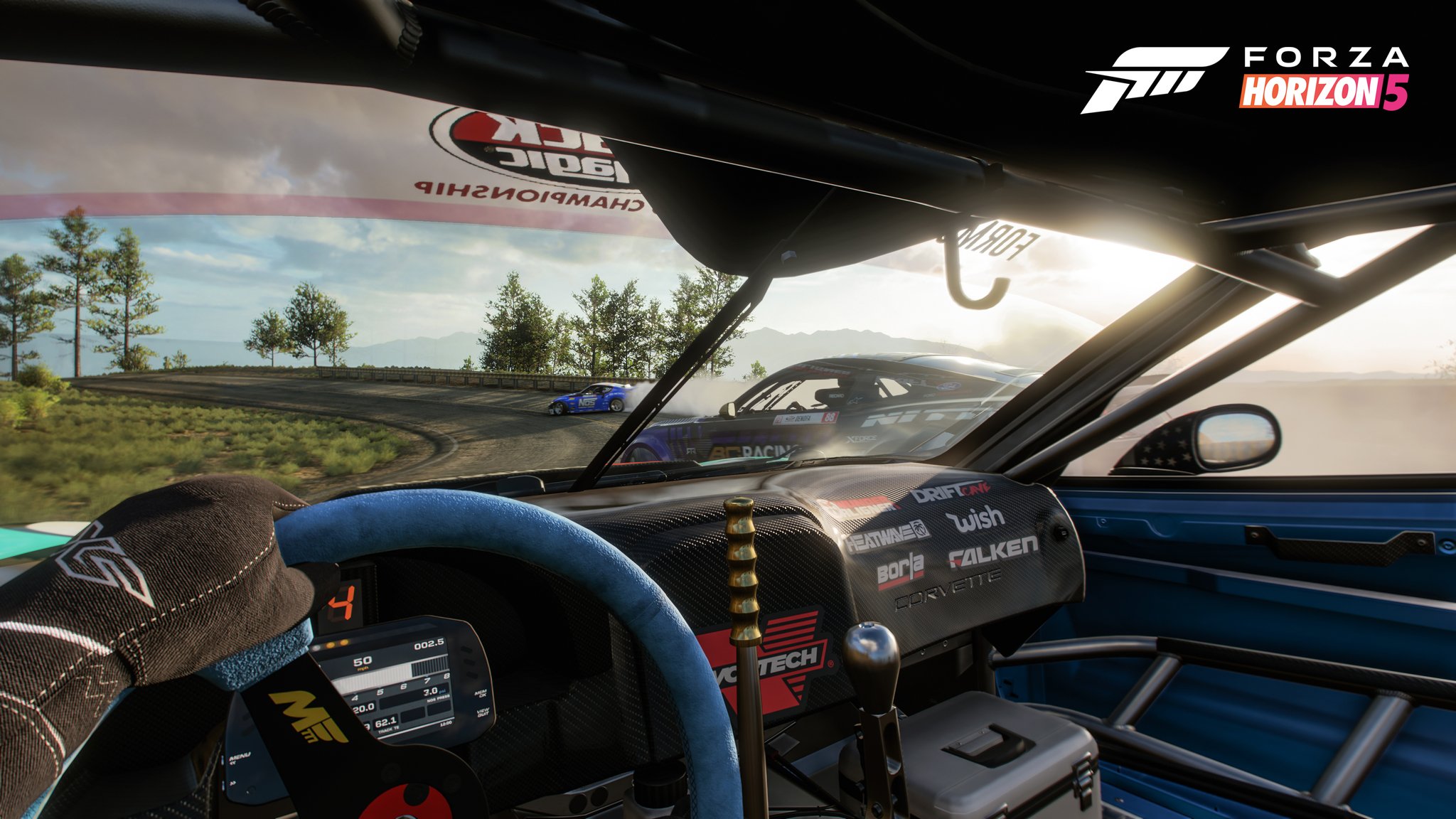
Forza Horizon 5 features hundreds of unique vehicles in its car lineup, each of which possesses different performance characteristics and styles. FH5 players can accomplish a lot simply by driving the cars stock (devoid of optional upgrades and alterations), especially since the wide variety of cars ensures there's a perfect vehicle for every situation. Still, using Forza Horizon 5's comprehensive upgrade and tune tools, players can obtain greater levels of performance, or design cars that specialize in certain events or scenarios.
You can create a "sleeper car" that packs a huge amount of raw power in an assuming body, refine an already-fast hypercar to achieve unbelievable speeds, build the ultimate off-roading machine, design the perfect drifting or drag racing car, and so much more. All of this is possible through Forza Horizon 5's Upgrade Shop, which lets you replace and install new parts in your cars. The tuning menu lets you tweak your car even further, with in-depth controls allowing you to alter every element to fit your precise needs. Tuning is especially important when you significantly upgrade a car beyond its original capabilities. For more information, be sure to check out our full guide to tuning cars in Forza Horizon 5.
Upgrading, and tuning in particular, can feature steep learning curves if you're not familiar with how to approach car upgrades or you're unsure what you want to accomplish. In this Forza Horizon 5 guide, we'll go over everything you need to know about upgrading your cars to your heart's content. While car upgrades aren't really necessary to play Forza Horizon 5 or even beat the game, it can unlock entirely new ways to play, with plenty of fun combinations available. This guide specifically covers car upgrades, and doesn't go over tuning, which is more advanced and has an even steeper learning curve.
How do I upgrade my car in Forza Horizon 5?

There are literally thousands of performance upgrades in Forza Horizon 5, spread across several different categories and sections. Each car has a unique selection of upgrades available to it, and different cars may lean more toward certain specialties than others (an off-road buggy isn't likely to become a drifting monster, for example). Despite the seemingly insurmountable number of options and upgrades, however, there are tips and tricks that apply to car upgrades in Forza Horizon 5 in general. Here's what you need to know.
General information
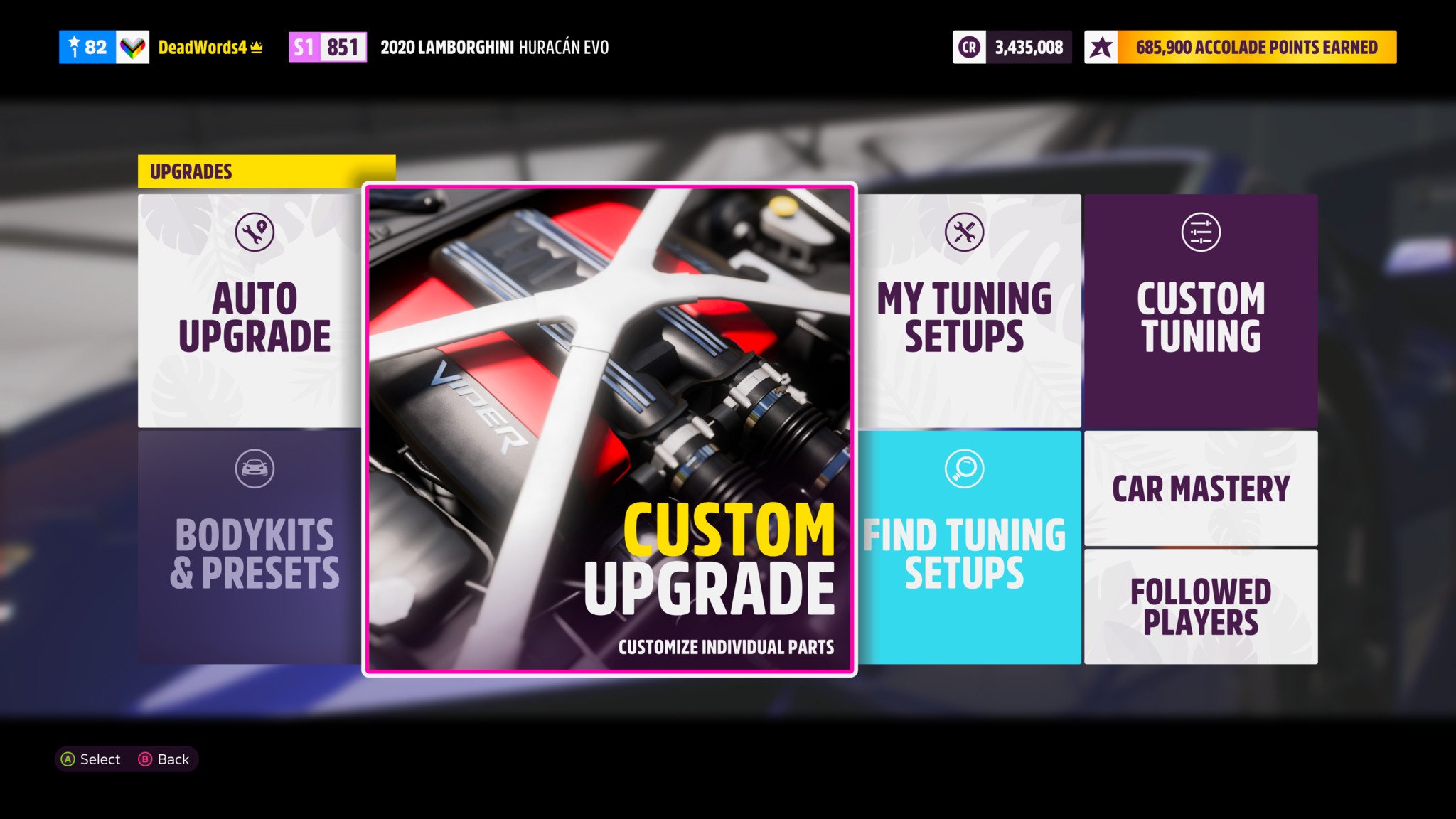
There are a plethora of routes to upgrade your cars in Forza Horizon 5, and plenty to keep in mind when doing so. Here's some general information to help with every car upgrade.
All the latest news, reviews, and guides for Windows and Xbox diehards.
Firstly, you need to know how to upgrade your vehicles in FH5. To do so, head to any Festival Site or Player House on the map. Once you're inside, stay on the "Garage" tab in the center of the resulting menu. Here, you can choose whichever car you wish to upgrade from "My cars," and then head over to "Upgrades & tuning" on the left-hand side to reach the upgrade menu.
There are different ways to upgrade
When it comes to getting the most out of your FH5 vehicles, "Custom upgrade" is the route to go, which lets you personalize and select individual part upgrades. This ensures you have exactly what you need, and lets you customize your car in fun ways. However, there are actually several potential ways to upgrade cars in Forza Horizon 5, including:
- Custom upgrade. This is the default option, and lets you personalize and select individual part upgrades and replacements. Requires additional work and may encourage tuning, as well.
- Auto upgrade. Many cars allow for the use of "Auto upgrade," which has Forza Horizon 5 automatically replace and upgrade parts on your cars to reach a specific PI Class. You don't get any control over these upgrades other than choosing your desired PI Class, and they may not be as effective as a custom or community-created upgrade, but can work well in a pinch.
- Bodykits & presets. A more specific version of "Auto upgrade," "Bodykits & presets" is only available for certain cars, and can give you one or more specific upgrade paths that achieve a desired goal in the car. This can mean turning a classic muscle car into a powerful dragster, outfitting a car for drifting, installing themed body kits, and other things. This section changes from car to car, and may be a solid alternative over "Auto upgrade," although you face many of the same compromises.
- Find tuning setups. Tuning is more advanced and nuanced than simply upgrading your car, but finding tuning setups already made by the community is a great way to not only skip this step but install all the basic upgrades your car needs as well. You can filter by PI Class and even find tunes designed for specific purposes, many of which may drastically improve the performance of your car. If you'd rather skip the upgrade process, finding custom tunes is a great way to go.
Everything beyond this point specifically talks about the "Custom upgrade" option, as other upgrade paths don't require you to consider any of this.
Choose your PI goal or objective first
Before you begin upgrading your car in Forza Horizon 5, it's important to decide how you want to upgrade it. Each car can have dozens or even hundreds of upgrade options, meaning it's imperative to choose a path before you begin. There are two things to bear in mind: your car's target PI Class, and your car's objective or specialty.
PI Class stands for "Performance Index Class," and is a number that roughly summarizes how good your car is, broken down into different categories including "Speed," "Handling," "Acceleration," "Launch," "Braking," and "Offroad." There are seven PI Classes in total, including:
- D-Class, which ranges from PI 100 to PI 500
- C-Class, which ranges from PI 501 to PI 600
- B-Class, which ranges from PI 601 to PI 700
- A-Class, which ranges from PI 701 to PI 800
- S1-Class, which ranges from PI 801 to PI 900
- S2-Class, which ranges from PI 901 to PI 998
- X-Class, which includes anything PI 999 or above
PI Class is vital in Forza Horizon 5, as it not just represents how performant your car is overall, it also dictates what Race Events and game modes in which your car can participate. PI Class is used to ensure players don't have unfair advantages with massively superior cars, as everything is contained within the same PI Class. Most cars can't touch every PI Class, but many can be upgraded through two or more. Before upgrading your car, it's a good idea to have a target PI Class in mind, and then attempt to upgrade your car to the very top of that PI Class (for example, an A-Class car with a PI of 701 would struggle to keep up with an A-Class car with a PI of 800, even though they can compete with each other).
For many players, C-, B-, and A-Class cars are the sweet spot, especially the latter, as they're a lot of fun to drive but are still perfectly manageable. S1-, S2-, and X-Class cars are powerful and fast, but they can be difficult to drive if you're not experienced. On the other hand, D-Class cars are the slowest cars in Forza Horizon 5, which of course means everything takes a little longer to do. PI Class is indubitably crucial in FH5, but it's also not all that matters. Solely pursuing a higher PI or only taking PI gains into account can occasionally limit you in your upgrades.
Of course, not all cars upgraded to the same PI Class are created equal. Cars can specialize at different race events and tasks, including but not limited to Road Races, Dirt Races, Cross-Country Races, PR Stunts, Drag Races, drifting, and more.
Before you begin upgrading your car, ask yourself what you want to do with it. A car built to excel on asphalt may struggle to go off-road, while a drift car may struggle at anything that isn't drifting, to name just a couple of examples. You can upgrade a car to excel in a variety of tasks, or a car that masters just one. Deciding what you want to use your car for before you begin upgrading will make the process much more seamless.
Max upgrades aren't always best
When upgrading cars in Forza Horizon 5, it's easy to default to the "best" upgrade in every category and max out a car. Pursuing the highest possible PI Class at all times does result in major increases across the board for most cars, and is often a dramatic transformation, but this isn't always the best route to take. Always choosing the max upgrade for a car can cause it to become difficult to drive if it isn't tuned properly, a process that requires further knowledge and experience over simply upgrading a car.
When upgrading a car, keep in mind the above tip and aim for a specific PI Class (and even a specialty) before you begin. There's absolutely nothing stopping you from max upgrading a car regardless, but it's important to remember doing so may also require additional tuning. A car's stock tune is usually pretty solid, and can handle a lot of upgrades pretty well, but major changes or upgrades can cause the tune to no longer be able to keep up with the car.
Finally, cars with the ultimate upgrades in every area can be a lot of fun to drive around, but sometimes aren't practical for actual races or events, unless you have a specific goal in mind.
Weight is always important
A consistent factor when upgrading your vehicles is managing weight. A car's weight has huge ramifications for how it handles and performs, and directly affects how effective your car's engine is at getting things moving. Keeping weight in mind while upgrading your cars is perpetually a good idea, and can help you compare the pros and cons of various upgrades. This is especially true when considering PI, as how much PI your car rises with a specific upgrade doesn't always tell the entire story.
Lower weight is almost always a good choice (with a few exceptions), but you should also be aware of your car's power-to-weight ratio. This number takes your vehicle's horsepower (which represents how powerful your engine is) and divides it by its total weight. The higher this number is, the better. For example, a car with 1,000 horsepower that weighs 2,000 pounds has a power-to-weight ratio of 1:2, which is a very solid number. You may notice upgrade parts that raise your PI and technically make your car more powerful, but actually add enough weight to lower your overall power-to-weight ratio. In many cases, these upgrades may not be worth that trade-off.
Experiment and make changes
There's no one right way to upgrade cars in Forza Horizon 5. This guide focuses on giving you all the basic information you need, but ultimately the best way to learn how to upgrade (and tune) is to experiment with different combinations and drive the finished products. It's easy to upgrade cars in Forza Horizon 5 continually, and you can also undo changes or make new ones at any point during the process.
As you upgrade your cars in Forza Horizon 5, don't hesitate to backtrack to sections you've already visited to consider different paths or upgrades, especially if you have a specific goal in mind that can be better reached another way. Even completely starting over or undoing huge swathes of progress shouldn't be a deterrent, as it all contributes to better and more enjoyable driving experiences.
Conversion upgrades

Conversion upgrades are massive, fundamental alterations you can make to your car, which can have huge effects on the overall driving experience and your options available elsewhere when upgrading. It's recommended to start here because of this, as it helps prevent unnecessary backtracking later on in the process. Not every car will have a ton of conversion options, but here's what you can expect to see.
- Engine swap. Many cars let you replace their stock engine with an alternative power source, which can dramatically affect how the car drives and how you're able to upgrade it in the future. Engine swaps can unlock higher levels of performance, especially in older cars, or provide other benefits like a better power-to-weight ratio, superior performance in specific PI categories and metrics, or different upgrade paths not available elsewhere.
- Stock engines tend to have plenty of capable upgrades available, so engine swaps often aren't necessary, especially if you're not trying to max out the car
- Engine swaps can also be among the most expensive upgrade parts, so keep this in mind if you're on a budget
- Some cars may have multiple engine swap options, with each varying wildly. When comparing engine options, remember your objectives and target PI Class, and remember that the most expensive option isn't always the most appropriate
- Drivetrain swap. Swapping out your car's drivetrain for an alternative can have just as significant effects as a full engine swap, and completely changes how the car drives. This refers to which wheels are receiving power from the engine, with three different options available in the game. For many players, the go-to drivetrain in any situation is AWD, or all-wheel drive, but this isn't always the best option. Here's what you need to know about each drivetrain option.
- FWD, or front-wheel drive, is rather uncommon in Forza Horizon 5. While many cars (especially older vehicles) may have this as the default drivetrain, it's rare to see it as an upgrade option on other cars. FWD isn't bad, but it is more prone to understeer (when the car doesn't turn as much as expected or doesn't respond around corners), and isn't usually an option for upgrade. If a car is FWD when stock, it may not be necessary to do a drivetrain swap immediately. Still, FWD isn't well suited to higher PI Classes
- RWD, or rear-wheel drive, is very common in Forza Horizon 5, both as a stock drivetrain and as an upgrade option. RWD cars are more prone to oversteer (when the car turns more than expected or loses control around corners), which is typically seen as more manageable than understeer. RWD cars usually don't require a drivetrain swap, unless you believe AWD is more appropriate. RWD is especially suited for drifting cars, as drifting is essentially controlled oversteer.
- AWD, or all-wheel drive, is the go-to upgrade option for many players, and does provide a lot of immediate benefits. Since all wheels are powered, AWD cars tend to have greater launch and acceleration, as well as increased handling in a variety of situations. This is the preferred drivetrain for off-road and rally cars, and can even work well for high-powered drift cars. However, AWD isn't always perfect. Some cars, especially older vehicles, may not handle as expected with AWD. In lower PI Classes, switching to AWD can also drastically decrease your car's top speed, since limited engine power is being spread to more wheels. Swapping your car's drivetrain to AWD (if it isn't the stock option) can unlock additional tuning options alongside increasing your car's capabilities, but bear in mind that it isn't always the best option (especially if your car's stock drivetrain is already RWD)
- Aspiration. Aspiration refers to how air flows through your car's engine (a vital part of keeping a car running and performing well). Most car engines tend to be naturally aspirated, meaning they don't have additional help pushing air through, but other cars feature parts like turbochargers and superchargers that provide massive boosts to horsepower. Aspiration upgrades let you add a turbocharger or supercharger to your car, with a few different options available depending on the car and engine.
- Aspiration upgrades almost always add weight to your car, but the increase in power often makes the weight gain worth it. Keep in mind that not every car requires an aspiration upgrade, especially in the lower PI Classes, and you may be able to find better benefits with other upgrades
- The choice between turbocharger and supercharger ultimately comes down to preference. Superchargers have a more immediate effect when you first launch or accelerate, while turbochargers take a second to kick in, but turbochargers usually add effect speed and horsepower more overall (especially with additional upgrades) while occasionally being lighter
- Body kit. Some cars feature advanced body upgrades that heavily alter your car's appearance and, in many cases, its handling. Some of these cars also feature full body kit conversion upgrades, which combine several of these aero and appearance upgrades into a singular upgrade. Body kits usually give your car a wider, more aggressive look, and it ultimately comes down to personal preference whether or not you like it. There are some performance benefits, such as improved handling, but body kit upgrades can increase your car's weight and restrict your tuning options for downforce, so there are trade-offs involved.
Aero and appearance upgrades
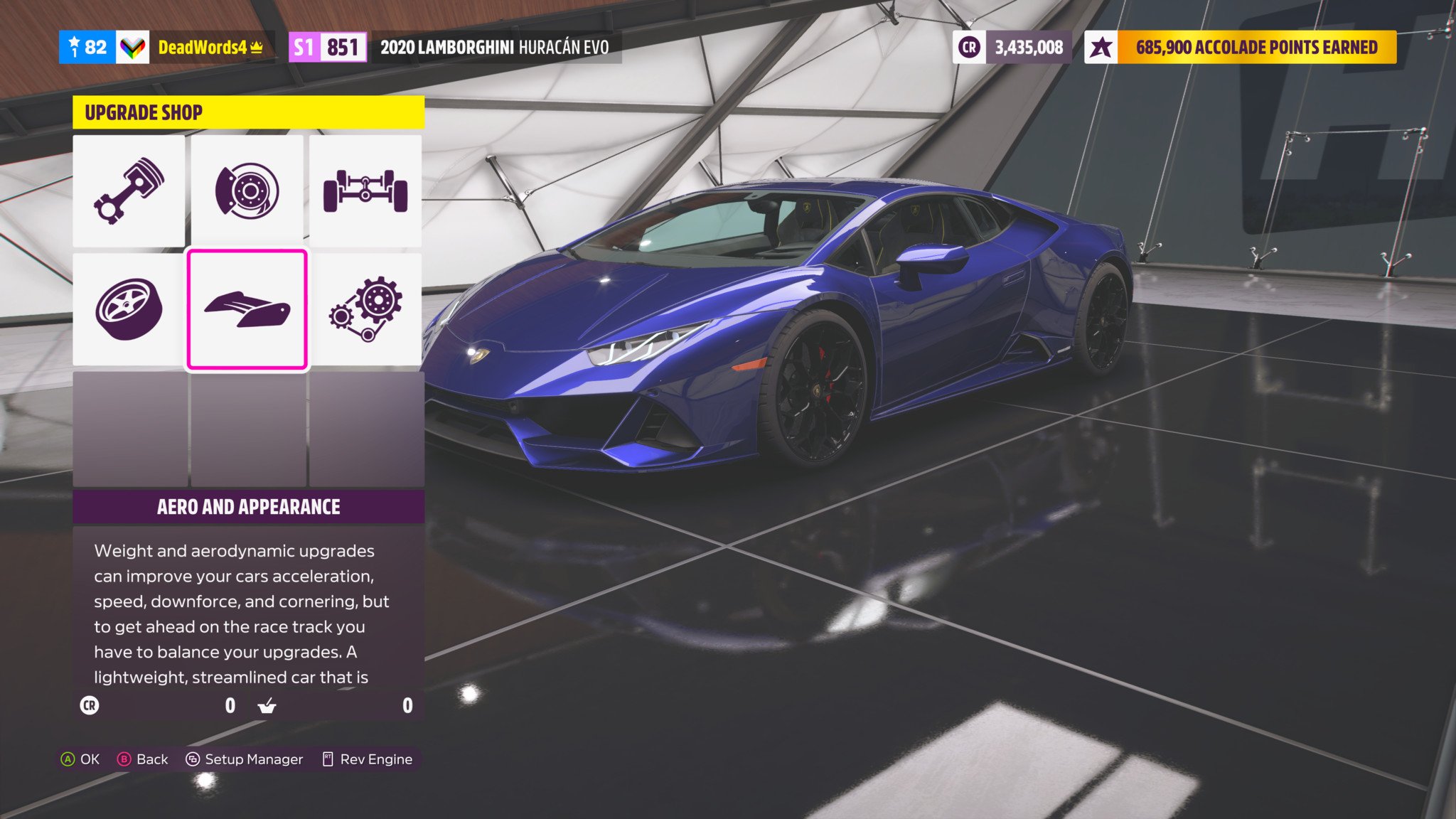
Aero and appearance upgrades include front and rear downforce upgrades, and body kit pieces like front and rear bumper replacements, side skirts, hoods, and more. This section is a great way to customize some cars, as well as shave off weight in some cases. Most of the time, though, players will come here to install front splitters or rear spoilers to unlock downforce tuning, which changes how much downward force is pressing your car to the ground (improving top speed and acceleration or handling and turning).
It's always worth checking this section to see whether there are any fun cosmetic upgrades or ways to lose a few pounds, but lower PI Class cars very likely don't need the additional downforce or tuning options provided by the consistent upgrades always found here. These aero upgrades should be considered if you upgrade a car into S1-Class or higher (and in some cases A-Class), or if you upgrade your car and find that it's not handling well around corners and easily loses traction.
Tire and rim upgrades
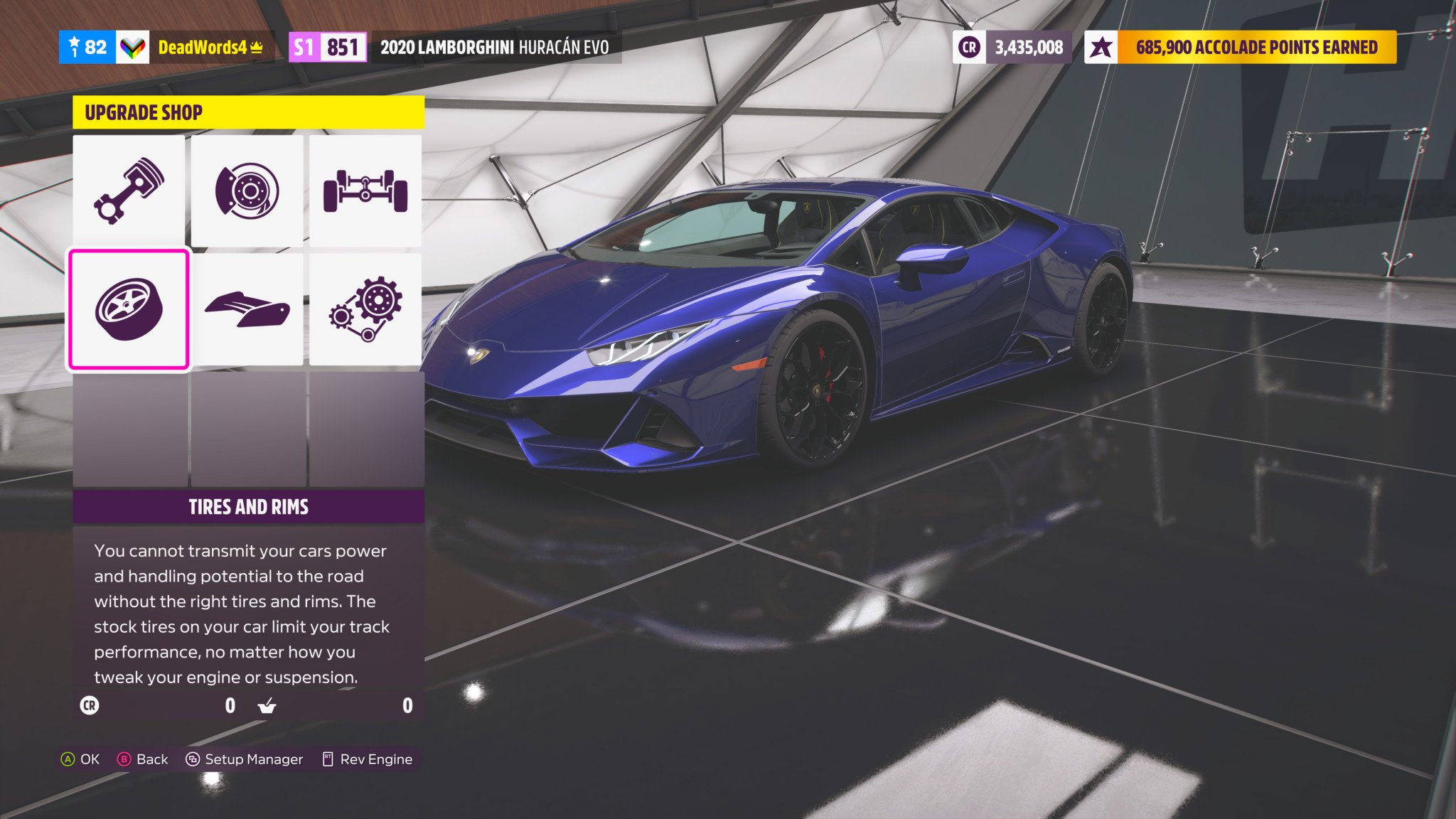
One of the biggest single categories for upgrades is the tires and rims section, which can move your car into an entirely different league or give you the handling refinements you were looking for. How many options are available in this section varies a lot from car to car, but there are five general upgrades to be found here.
- Tire compound. This upgrade changes the tires installed on your car, and provides some of the single biggest PI gains of any upgrades out there. Your car's handling and performance can alter significantly based on the tires you install on it, making it easy to select the max option even when it's not appropriate.
- Street, Sport, Semi-Slick Race, and Slick Race tires are all designed for use on road, but for different PI Classes. While Slick Race tires do provide the greatest boost to PI Class, many cars can't actually make use of the tires and the upgrade is wasted. This is especially important when you have a specific PI Class target, as tires can use up a lot of your PI budget without giving you all the benefits
- Street tires tend to be good for D- to C-Class, Sport tires tend to be good for B-Class, and Semi-Slick Race tires should be the go-to for upper A-Class and above. Slick Race tires are superior in specific situations (on smooth roads in great conditions), or when you're trying to beat some speed records, but Semi-Slick tires are more well rounded
- Most of the other tire options are usually the best choice for specific goals. Drag tires are usually the best for drag cars, Drift tires are usually the best for drift cards, Offroad tires are usually the best for offroad and cross-country racing cars, and Rally tires are usually the best for dirt racing and rally cars
- Snow tires and Vintage Race tires (where applicable) are purely situational. Snow tires are better on specifically snow and ice (which is less common in Forza Horizon 5), but Offroad tires are better offroad in general. Vintage race tires can be a good tire upgrade for classic cars if you don't want to go for one of the other superior road tires
- Tire width. This upgrade changes the width of your tires, and is usually divided into separate front and rear options. Having more tire touching the road is almost always better for traction and handling, as well as launch performance and even acceleration.
- Upgrading tire width for any powered wheels is often a safe and solid upgrade. Upgrading rear wheel tire width is especially useful a lot of the time
- While you do add weight to your car when upgrading tire width, the other advantages tend to be worth it
- Offroad and rally cars benefit a lot from upgraded tire width, as more tire equals more grip when grip can be scarce
- Rim style. This upgrade can be purely cosmetic, for weight reduction, or both! There are dozens upon dozens of rim styles in Forza Horizon 5, most of which can be installed on practically any car. Changing out stock rims can be a great way of losing a couple dozen pounds while upgrading your car's appearance.
- Rim size. The size of your wheels actually does have a pretty direct effect on your car's handling. Larger rims mean less tire deformation when turning, while smaller rims mean more tire deformation. Which way benefits your car the most and whether or not the upgrade is worth it at all depends entirely on the car and your goals, especially since increased rim sizes often come with a hefty increase in weight. This upgrade is normally separated into front and rear options.
- Larger rim sizes may be worth it on high performance, road-bound vehicles, where the increased handling benefits are felt the most
- Offroad and rally cars actually benefit more from smaller rims, as tire deformation often equals greater grip
- Of course, increasing your car's rim size can be a matter of appearance and personal preference
- Track width. This upgrade refers to how far apart the wheels on your car are, and is usually divided into front and rear options. Upgrading your track width is often a great upgrade since it provides improved handling on and off the road without increasing weight. This is especially true for powered wheels, and even more so for the rear wheels.
Drivetrain upgrades

Drivetrain upgrades aren't going to revolutionize your car's performance completely, but it can grant small boosts to how quickly your car shifts, grant you additional tuning options for little or no PI cost, and provide several ways to reduce weight.
- Clutch and driveline. Both of these upgrades are fairly straightforward and are often solid options (especially when you're looking for small PI gains). Clutch upgrades help your car shift faster, a tiny benefit that nonetheless directly affects how your car drives, while driveline upgrades simply reduce weight.
- Transmission. Whether transmission upgrades are worth it depends on a few things. Transmission upgrades do reduce shift times, but they also often add weight and can even reduce your car's overall performance. That's because transmission upgrades unlock gear ratio tuning options, and their benefits rely a lot on using these tuning options. If you're not tuning your car (or aren't going in-depth, as gear ratio tuning is pretty advanced), then these upgrades may not be worth it.
- Transmission upgrades can be worth it if you install huge upgrades to your car's engine, as it enables you to tune at least the final gear ratio afterward (major engine upgrades can often end with the stock gear ratio tune not taking advantage of higher gears)
- Differential. This upgrade should be installed every single time unless you're trying to stick to an extremely tight budget. Differentials control wheelspin and whether different wheels are allowed to spin at different speeds (and the difference that's allowed), which can have a big effect on handling. Upgrading your car's differential doesn't cost any PI or weight, doesn't cost a lot of Credits, and unlocks differential tuning so you can finetune your car's differential after upgrading. There are different kinds of differentials, which come with preinstalled tunes for road, rally, and offroad racing, as well as drifting, so you don't have to touch the tuning menu if you don't want to.
Platform and handling upgrades
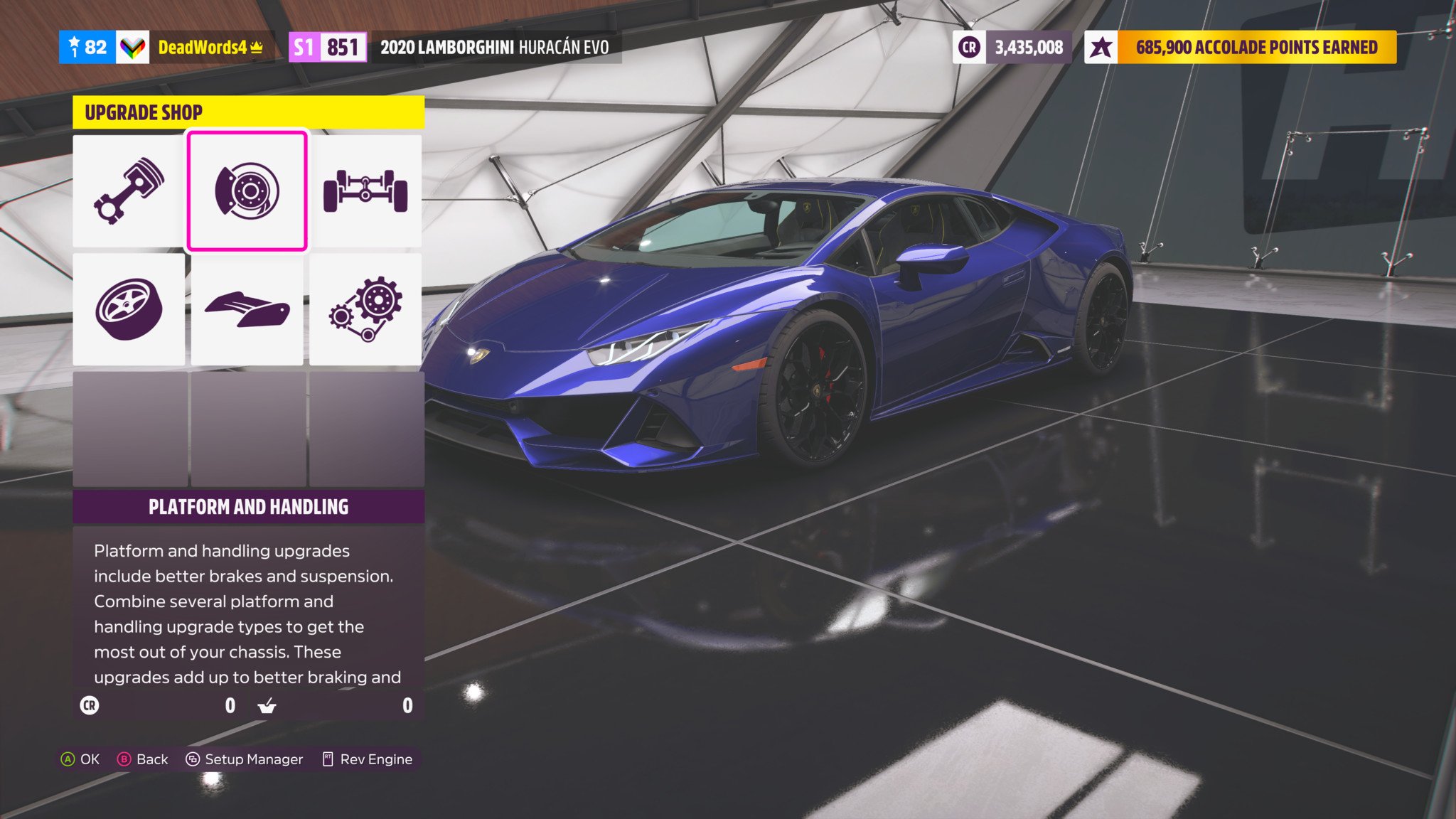
Platform and handling upgrades directly affect how your car handles and have little to do with power or speed. Still, this is a great place to go for serious handling boosts, weight reduction, braking improvements, and additional tuning options to squeeze a little more out of your car.
- Brakes. Brake upgrades reduce weight and improve your car's stopping power, which seems great on paper. However, these upgrades mirror tires in that it's easy to jump to the best option, even if your car can't take advantage. Brake upgrades should only be considered for higher-end cars or big PI Class jumps, or if you notice your car is losing grip while braking.
- Antiroll bars. These upgrades reduce the amount of sway allowed between the left and right sides of your car, and grants considerable improvements to handling alongside weight reduction and tuning options. Antiroll bars don't cost a lot of PI to install, so it's almost always a great idea to jump straight to the Race versions. The benefits provided by antiroll bars are especially noticeable on older or lower-end cars. Antiroll bars are normally separated into front and rear options.
- Chassis reinforcement. Chassis reinforcement upgrades, or roll cages, are a mixed bag, and whether it's worth it depends on the car. Roll cages reduce sway and flexing in your car's chassis and can improve overall stability, but they also add a huge amount of weight. Older or lower-end cars that are being significantly upgraded into much higher PI Classes can greatly benefit from roll cages, as can most offroad or rally cars. Higher-end cars and cars enjoying minor upgrades probably don't need chassis reinforcement unless you notice a lot of chassis flexing or instability.
- Weight reduction. As you may have guessed, weight reduction upgrades reduce the overall weight of your car and are great upgrades. Simply reducing the weight of your car without improving anything else can boost your car's handling, acceleration, launch capabilities, and braking all in one go. The one issue with weight reduction is that it comes with huge PI gains, making it a costly upgrade when you're working with a PI budget. Weight reduction can have adverse effects on some offroad or rally cars, so keep that in mind.
Engine upgrades

Engine upgrades improve the capabilities of your car's engine, and bear increases in power and changes in weight. Engine upgrades can drastically alter your car's speed, acceleration, and launch, but it can also negatively affect handling (the more power you're working with, the harder it is to control it). It's normally recommended to visit engine upgrades after everything else, unless your goal is to eke out as much power or speed from a car as you can.
When upgrading engine parts, always remember your power-to-weight ratio. Flywheels are solid minor upgrades because they simply reduce weight, while exhaust and camshaft upgrades are great starting places to power up your engine without increasing weight. If your car has the parts installed and upgrades are available, improvements to turbochargers or superchargers will increase your car's weight but can offer large gains in power.
Other engine upgrades can be used to reach your PI Class target and fill in gaps where necessary, as long as you keep in mind your power-to-weight ratio and how much power your car can handle before it becomes unwieldy. Unless you're driving with simulation settings in Forza Horizon 5, with options like realistic damage simulation and engine heat, cooling upgrades are almost always not worth the power gains, since they usually come with big increases in weight and lower your power-to-weight ratio.
What is Forza Horizon 5?

Forza Horizon 5 is an open-world racing game from Playground Games and Xbox Game Studios. While indubitably more of an arcade racer, FH5 does feature simulation-like elements and settings, and lets players customize and upgrade their cars through the Upgrade Shop or tuning menu. Playground elevated its status as a premier developer with the release of Forza Horizon 5, which delivered all of the studio's promises and quickly became one of the best Xbox racing games you can play.
Forza Horizon 5 features a huge and widely diverse map, hundreds of incredible cars to drive, and a nearly endless amount of content to explore that continues to grow and expand over time. The Forza Horizon 5 Festival Playlist introduces new reasons to play every week, and Playground is committed to supporting its flagship project for years to come.
If you're a fan of racing games or are interested in experiencing one, Forza Horizon 5 is one of the best in the entire genre. FH5 is now available on a huge number of platforms, including Xbox Series X, Xbox Series S, Xbox One, PC, Xbox Game Pass, and Xbox Cloud Gaming.
In our Forza Horizon 5 review, we concluded that Playground Games has crafted the "unchallenged champion of open-world racers," and one of the best Xbox games released in 2021. If you want to learn more about this ambitious racing title, check out our ultimate guide to Forza Horizon 5.

The best open-world racer
Playground Games has delivered their latest masterpiece with Forza Horizon 5, which features the series' most diverse map and largest car list yet. Forza Horizon 5 somehow fulfills its ambitious promises to be the best open-world racer right now, and one of the best racing games in general.

All your gaming needs, in one subscription.
Is the Xbox Game Pass Ultimate the best value in all of gaming? It's possible. Ultimate bundles your Xbox Live Gold subscription, an Xbox Game Pass subscription for both Xbox consoles and Windows PCs, and Xbox Cloud Gaming for on-the-go. That means access to hundreds of games, with more added all the time, for a single monthly subscription cost.

Zachary Boddy (They / Them) is a Staff Writer for Windows Central, primarily focused on covering the latest news in tech and gaming, the best Xbox and PC games, and the most interesting Windows and Xbox hardware. They have been gaming and writing for most of their life starting with the original Xbox, and started out as a freelancer for Windows Central and its sister sites in 2019. Now a full-fledged Staff Writer, Zachary has expanded from only writing about all things Minecraft to covering practically everything on which Windows Central is an expert, especially when it comes to Microsoft.
